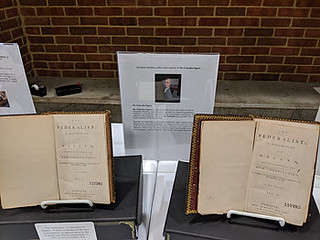Do you remember what you were doing on 9/11 when you first heard the news? I and many people can you tell you exactly where we were and what we were doing. I was getting ready for a legal research workshop which involved print resources. One of the law librarians I worked with set up televisions so that students, faculty, and staff could watch the news coverage. I taught my legal research workshop and my students completed the exercise but we were all distracted and found it difficult to concentrate.
In the not-quite two decades since 9/11, how are we preserving what we know about that day?
The National Park Service is building a memorial for Flight 93. Flight 93 was the passenger flight from New Jersey, bound for California that was part of the September 11 attacks. Passengers attempted to regain control of the plane and it crashed into a field in Somerset County, Pennsylvania. All 44 people on board were killed, including the hijackers. On September 24, 2002, Congress passed the Flight 93 National Memorial Act. The Act “Established a Memorial at the September 11, 2001, crash site of United Airlines Flight 93 in Stonycreek Township, Somerset County, Pennsylvania, to honor the passengers and crew of Flight 93.” The Act also designated the National Memorial as a unit of the National Park system. The Memorial Plaza, Wall of Names, and Entrance Road were dedicated on September 10, 2011. The Visitor Center, Learning Center, and Walkway to the Memorial Plaza were dedicated on September 10, 2015. The Tower of Voices is currently in development. On the National Park Service Flight 93 Sources and Detailed Information webpage, you can find the cockpit voice recorder transcript, the Flight Path Study by the NTSB, transcripts of passenger and crew phone calls, the flight seating chart, and photographs of the crash site.
The Library of Congress has a September 11, 2001, Documentary Project. “The September 11, 2001 Documentary Project captures the reactions, eyewitness accounts, and diverse opinions of Americans and others in the months that followed the terrorist attacks on the World Trade Center, the Pentagon, and United Airlines Flight 93.” The Collection contains 400 audio and video recordings, 8,100 manuscript materials, 421 graphic and photographic materials, electronic media, and artifacts.
After the attacks, Congress formed the National Commission on Terrorist Attacks Upon the United States (9/11 Commission) through Public Law 107 – 306 – Intelligence Authorization Act for Fiscal Year 2003. In addition to reading the text of the public law on Govinfo.gov, you can also read President Bush’s signing statement and remarks at the signing. The 9/11 Commission gave the National Archives approximately 570 cubic feet of textual records. Although many of the records are still classified, the unclassified records are being processed as documents are requested. Many of the Memorandums for the Record from the over 1200 fact-finding interviews are online. You can see the list of released material on the National Archives’ 9/11 Commission Series website.
New York has established The National 9/11 Memorial Museum with the mission of “exploring the implications of the events of 9/11, documenting the impact of those events and exploring 9/11’s continuing significance.”
The September 11 Digital Archive has been added to the Library of Congress. They have been “collecting and archiving first-hand accounts, emails and other electronic communications, digital photographs and artworks, and a range of other digital materials related to the attacks.”
There are other 9/11 resources out there but the final resource to highlight is the Internet Archive’s Understanding 9/11: a Television News Archive. This archive covers news of 9/11 broadcaster in the U.S. and Internationally.
We will never forget.


